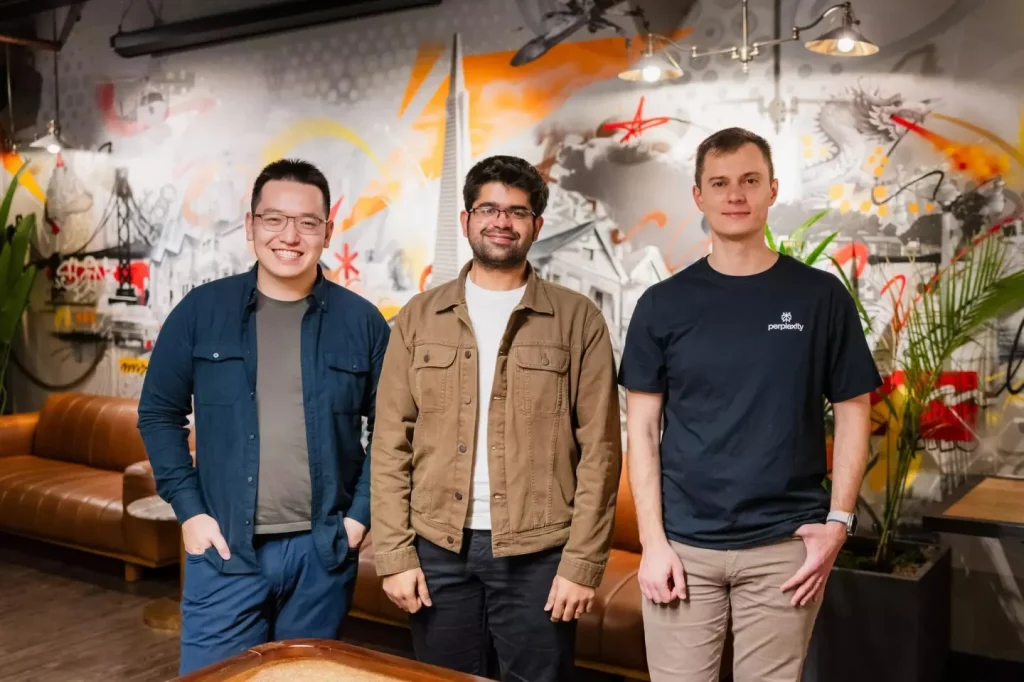(April 15, 2025) It’s a compelling indicator of global influence when an AI tool built by a young Indian-origin entrepreneur becomes a daily companion for researchers, students, and professionals worldwide. Aravind Srinivas, the Chennai-born co-founder and CEO of Perplexity AI, has emerged as one of the most exciting voices in AI innovation today.
Like Sundar Pichai, CEO of Google who also hails from Chennai and studied at IIT Kharagpur, Aravind too comes from humble beginnings rooted in South India’s academic ecosystem. While Sundar studied at Vana Vani school inside the IIT Madras campus before moving on to Kharagpur, Aravind completed his BTech from IIT Madras itself. Interestingly, neither studied Computer Science during their B.Tech in India, and yet both have risen to become influential figures in the global tech landscape. Their shared roots and convergence in the tech world came into focus recently at the AI Summit co-hosted by France and India. Reflecting on their meeting, Aravind said, “Was a fun conversation connecting on our common roots and the work we’re doing to advancing search.”
While Sundar Pichai is a well-established name in the tech world, Aravind’s accomplishments and contributions mark the distance he has traveled, geographically and intellectually in a short frame of time. What began as a catalytic entrepreneurial venture in 2022 has now grown into one of the most talked-about AI startups in the world, with Perplexity AI used by millions across global academic and professional circles. Asked how he’d like to be remembered during an interview at the Stanford Graduate School of Business, Aravind gave a simple but profound answer, saying he wanted to be remembered “as someone who is helping make the world smarter.” The entrepreneur hopes that users of Perplexity “sleep wiser than when they woke up.”
View this post on Instagram
Early exposure to AI and machine learning
Like many ambitious Indian students, Aravind started out aiming to crack the highly competitive Joint Entrance Examination. Although he missed out on Computer Science by a slim margin, he entered IIT Madras as an Electrical Engineering student—a turn of events that later proved to be fortuitous. It was here that a roommate introduced him to Kaggle, a data science competition platform that would become a cornerstone of his journey.
Without prior coding experience or access to sophisticated infrastructure, Aravind taught himself machine learning by exploring open-source libraries like Scikit-learn. “I downloaded the dataset, opened Scikit-learn, and started playing around. It was all trial and error, but I got hooked,” Aravind recalled about his first experience with machine learning. He also relied on free online content, particularly Stanford’s popular machine learning lectures, and quickly began applying those concepts. What started as trial-and-error soon became a pathway to success, leading him to win competitions and eventually secure an internship in Bangalore, where he worked on recommender systems.
Academic brilliance and tenacity at IIT Madras
Even as a school student in Chennai, Aravind had demonstrated academic excellence. Recognized with prestigious scholarships and guided by a local culture that valued knowledge over wealth, he developed a mindset that prioritized deep learning over superficial results. His love for cricket helped hone his analytical thinking, especially when it came to tracking statistics and performance trends. The academic rigour of IIT Madras helped him cultivate the intellectual stamina that would later shape his approach to solving complex problems.

PhD struggles and growth at UC Berkeley
Earning admission into the PhD program at UC Berkeley marked a significant step in his journey, though it came with its own challenges. Aravind didn’t own a personal computer at the time, so he relied entirely on shared cloud-based computational resources. His day often began at 5:30 AM and stretched until 8 PM, using limited access to run experiments. Working without an official advisor, he operated from a modest lab space, putting in long hours driven not by ambition alone but by an unshakable passion for learning and discovery. “I didn’t see it as hard work or some grand effort. I was just obsessed,” Aravind remarked while talking about his time as a PhD scholar.
Adapting to the American research environment
Transitioning to life in the United States presented a series of logistical and emotional hurdles. Despite these barriers, he carved a niche for himself as a dedicated researcher. His collaborations, publications, and increasing command over AI theory and application added to his growing confidence. It was during this phase that he developed a keen appreciation for the importance of citations and verifiable sources. There were the elements that would become core to his startup’s mission. He discovered that this very concept had once inspired the architecture behind Google’s original search engine.
From big tech intern to startup founder
His internships at institutions like OpenAI, DeepMind, and Google gave him a front-row seat to how the best minds built cutting-edge models. But it also exposed what was lacking. “The traditional tech industry was too focused on incremental improvements,” he noted.
Inspired by Elon Musk’s ethos—“Nobody can defeat you if you don’t want to be defeated,” Aravind chose not to follow, but to lead. “There’s even this quote from Charlie Munger,” he said “the best thing you can do for another human being is to help them learn and know more,” that motivated him.

Perplexity AI co-founders , Johnny Ho, Aravind Srinivas and Dennis Yarats | Photo Credit: Fortune
Founding Perplexity AI with a clear vision
A big idea needs a big team. Aravind brought in Johnny Ho, a legend in competitive programming. “Only one guy has beaten Turis at the IOI ever and that was Johnny,” he said. Denis Yarats, a fellow Berkeley researcher, brought deep AI engineering experience. In 2022, the three of them co-founded Perplexity AI. The mission was to build an answer engine that not only delivers facts but explains the source and context behind them.
We asked the question, what if an AI always responded like an academic?
Aravind Srinivas
It was the foundational idea behind Perplexity, creating an AI system that cites its sources and prioritizes accuracy and transparency, inspired by the academic research process.
Recognizing what they lacked, they hired specialists in frontend, full stack, and product design. “Find the people who multiplicate you,” Aravind explained. It’s a mantra that has guided Perplexity’s growth.
Pitching without pitch decks
When it came to raising capital, Aravind broke with startup convention. Instead of relying on polished presentations, he let the product speak for itself. Tech leaders like Yann LeCun and Jeff Dean were impressed not by decks but by firsthand experience with Perplexity. “We camped outside Yann LeCun’s office, played with a demo that searched his own tweets, and he said, ‘Okay fine, I want to invest.’” The same happened with Karpathy, Jeff Dean, and eventually, Jeff Bezos.
Scaling Perplexity to a multi-billion dollar AI venture
Within two years, Perplexity AI had established itself as a leader in AI-powered research tools. Valued at $9 billion, it became popular for its transparency and reliability. Aravind remained realistic about the platform’s limitations but committed to refining it further. “There are a lot of mistakes we still make but zoom out, and the mistakes will be reduced to one in 1,000 or 10,000,” he remarked. He made it clear that Perplexity would prioritize long-term trust over short-term gains, steering clear of ad models that compromised the user experience.
View this post on Instagram
Hands-on leadership and empowering the unexperienced
The startup faced scrutiny from traditional media outlets over content usage. Instead of reacting defensively, Aravind proposed a proactive solution of launching a publisher partnership program that shared ad revenue and offered direct access to Perplexity’s APIs. He also supported academic institutions like Northwestern University in researching how AI could support journalism.
Aravind’s leadership style is immersive. He uses the product daily, closely monitors user feedback, and prefers to remain hands-on. He believes in hiring people with potential rather than just experience, often betting on the unexperienced talent who have yet to make their mark but show promise and resilience. As he puts it:
I’ve actually tried to hire people with some chips on their shoulders, very talented, but they have not had their first major hit yet.
Aravind Srinivas
Empowering the world with smarter search today
Aravind views Perplexity not just as a product, but as a movement toward smarter, more accessible knowledge. “I would love for myself and Perplexity to be known as helping make the world smarter.” That vision goes beyond metrics. “If people feel smarter after using it, I would feel really, really glad.”
He believes AI has the potential to offer the same convenience and efficiency that billionaires enjoy to anyone with a question. From a modest Chennai upbringing to a boardroom in Silicon Valley, Aravind Srinivas’s story is not just about AI or entrepreneurship, but a blueprint for how passion, perseverance, and purpose can converge to reshape the future.
ALSO READ: Sundar Pichai: The Indian-origin CEO who made Google more global




